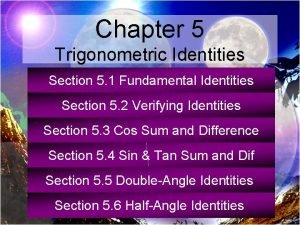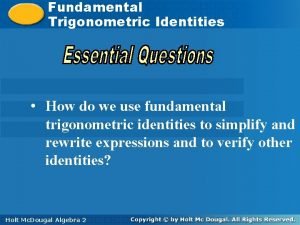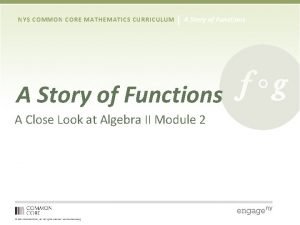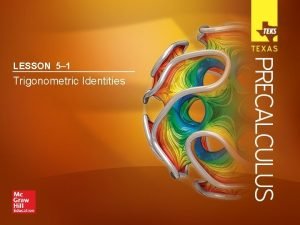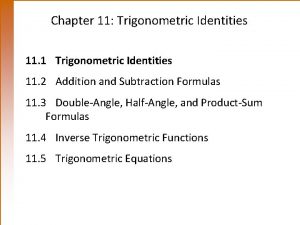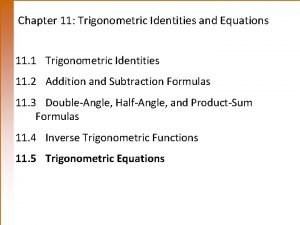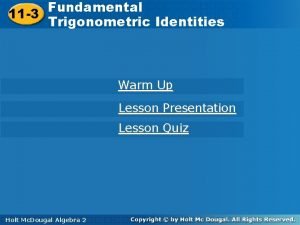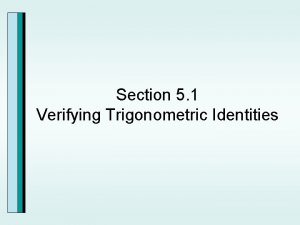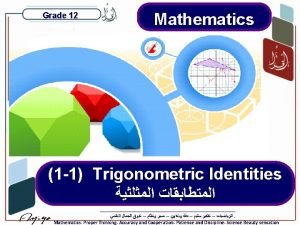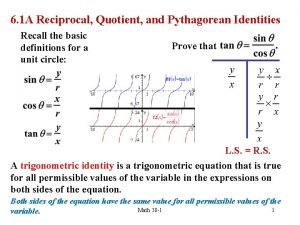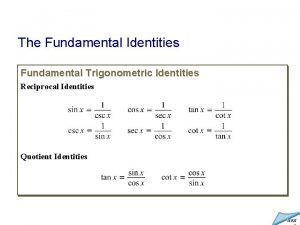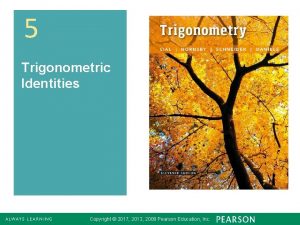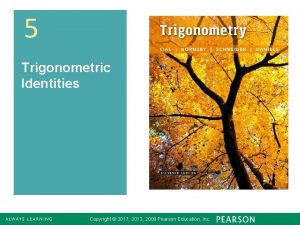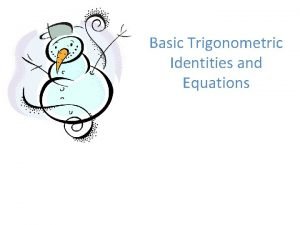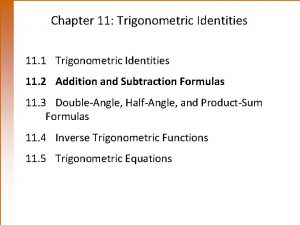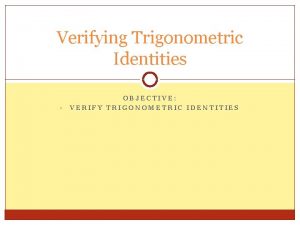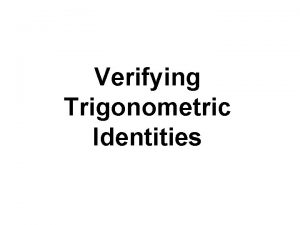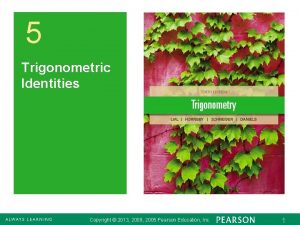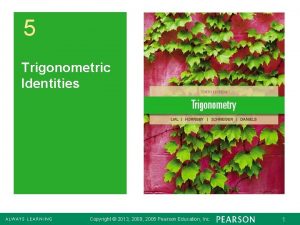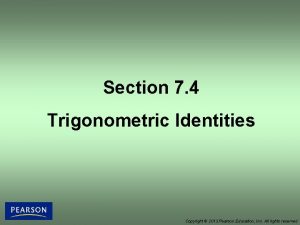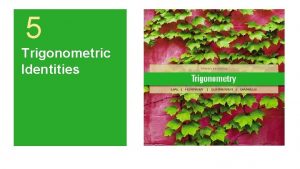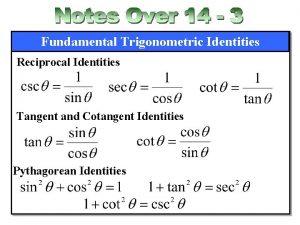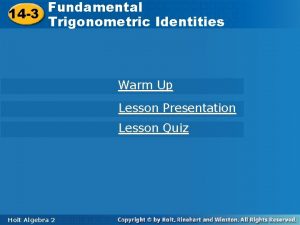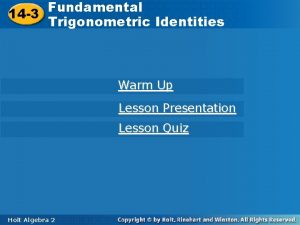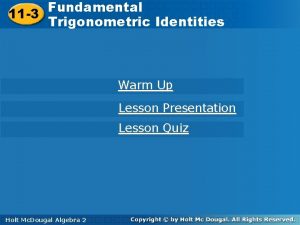7 Trigonometric Identities Copyright 2017 2013 2009 Pearson




















- Slides: 20

7 Trigonometric Identities Copyright © 2017, 2013, 2009 Pearson Education, Inc. 1

5. 2 Verifying Trigonometric Identities Strategies ▪ Verifying Identities by Working with One Side ▪ Verifying Identities by Working with Both Sides Copyright © 2017, 2013, 2009 Pearson Education, Inc. 2

Hints for Verifying Identities § Learn the fundamental identities. Whenever you see either side of a fundamental identity, the other side should come to mind. Also, be aware of equivalent forms of the fundamental identities. § Try to rewrite the more complicated side of the equation so that it is identical to the simpler side. Copyright © 2017, 2013, 2009 Pearson Education, Inc. 3

Hints for Verifying Identities § It is sometimes helpful to express all trigonometric functions in the equation in terms of sine and cosine and then simplify the result. § Usually, any factoring or indicated algebraic operations should be performed. For example, the expression can be factored as Copyright © 2017, 2013, 2009 Pearson Education, Inc. 4

Hints for Verifying Identities The sum or difference of two trigonometric expressions can be found in the same way as any other rational expression. For example, Copyright © 2017, 2013, 2009 Pearson Education, Inc. 5

Hints for Verifying Identities § As you select substitutions, keep in mind the side you are not changing, because it represents your goal. For example, to verify the identity find an identity that relates tan x to cos x. Since and the secant function is the best link between the two sides. Copyright © 2017, 2013, 2009 Pearson Education, Inc. 6

Hints for Verifying Identities § If an expression contains 1 + sin x, multiplying both numerator and denominator by 1 – sin x would give 1 – sin 2 x, which could be replaced with cos 2 x. Similar procedures apply for 1 – sin x, 1 + cos x, and 1 – cos x. Copyright © 2017, 2013, 2009 Pearson Education, Inc. 7

Caution The procedure for verifying identities is not the same as that of solving equations. Techniques used in solving equations, such as adding the same term to each side, and multiplying each side bythe same term, should not be used when working with identities. Copyright © 2017, 2013, 2009 Pearson Education, Inc. 8

Verifying Identities by Working with One Side To avoid the temptation to use algebraic properties of equations to verify identities, one strategy is to work with only one side and rewrite it to match the other side. Copyright © 2017, 2013, 2009 Pearson Education, Inc. 9

Example 1 VERIFYING AN IDENTITY (WORKING WITH ONE SIDE) Verify that the following equation is an identity. Work with the right side since it is more complicated. Right side of given equation Distributive property Left side of given equation Copyright © 2017, 2013, 2009 Pearson Education, Inc. 10

Example 2 VERIFYING AN IDENTITY (WORKING WITH ONE SIDE) Verify that the following equation is an identity. Distributive property Left side Right side Copyright © 2017, 2013, 2009 Pearson Education, Inc. 11

Example 3 VERIFYING AN IDENTITY (WORKING WITH ONE SIDE) Verify that is an identity. Copyright © 2017, 2013, 2009 Pearson Education, Inc. 12

Example 4 Verify that VERIFYING AN IDENTITY (WORKING WITH ONE SIDE) is an identity. Multiply by 1 in the form Copyright © 2017, 2013, 2009 Pearson Education, Inc. 13

Verifying Identities by Working with Both Sides If both sides of an identity appear to be equally complex, the identity can be verified by working independently on each side until they are changed into a common third result. Each step, on each side, must be reversible. Copyright © 2017, 2013, 2009 Pearson Education, Inc. 14

Example 5 VERIFYING AN IDENTITY (WORKING WITH BOTH SIDES) Verify that identity. is an Working with the left side: Multiply by 1 in the form Distributive property Copyright © 2017, 2013, 2009 Pearson Education, Inc. 15

Example 5 VERIFYING AN IDENTITY (WORKING WITH BOTH SIDES) (continued) Working with the right side: Factor the numerator. Factor the denominator. Copyright © 2017, 2013, 2009 Pearson Education, Inc. 16

Example 5 VERIFYING AN IDENTITY (WORKING WITH BOTH SIDES) (continued) Left side of given equation Right side of given equation Common third expression So, the identity is verified. Copyright © 2017, 2013, 2009 Pearson Education, Inc. 17

Example 6 APPLYING A PYTHAGOREAN IDENTITY TO ELECTRONICS Tuners in radios select a radio station by adjusting the frequency. A tuner may contain an inductor L and a capacitor, C. The energy stored in the inductor at time t is given by and the energy in the capacitor is given by where F is the frequency of the radio station and k is a constant. Copyright © 2017, 2013, 2009 Pearson Education, Inc. 18

Example 6 APPLYING A PYTHAGOREAN IDENTITY TO RADIOS (continued) The total energy E in the circuit is given by Show that E is a constant function. * *(Source: Weidner, R. and R. Sells, Elementary Classical Physics, Vol. 2, Allyn & Bacon. ) Copyright © 2017, 2013, 2009 Pearson Education, Inc. 19

Example 6 APPLYING A PYTHAGOREAN IDENTITY TO RADIOS (continued) Factor. Since k is a constant, E(t) is a constant function. Copyright © 2017, 2013, 2009 Pearson Education, Inc. 20
 Copyright 2009 pearson education inc
Copyright 2009 pearson education inc Copyright 2009 pearson education inc
Copyright 2009 pearson education inc Copyright 2009 pearson education inc
Copyright 2009 pearson education inc Copyright 2009 pearson education inc
Copyright 2009 pearson education inc Copyright 2009
Copyright 2009 2009 pearson education inc
2009 pearson education inc 5-1 trigonometric identities
5-1 trigonometric identities Verifying trigonometric identities calculator
Verifying trigonometric identities calculator Fundamental trig limit
Fundamental trig limit Fundamental trigonometric identities
Fundamental trigonometric identities Trigonometric identities
Trigonometric identities Lesson 10 basic trigonometric identities from graphs
Lesson 10 basic trigonometric identities from graphs Lesson 5: the cosine function
Lesson 5: the cosine function 11 trig identities
11 trig identities Cos(2x) trig identity
Cos(2x) trig identity 3 identities of trigonometry
3 identities of trigonometry 5-1 trigonometric identities
5-1 trigonometric identities 7-1 basic trigonometric identities
7-1 basic trigonometric identities Trigonometric identities
Trigonometric identities Proving identities grade 12
Proving identities grade 12 Quotient reciprocal and pythagorean identities
Quotient reciprocal and pythagorean identities






